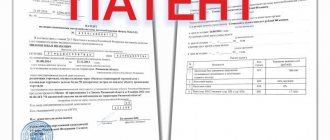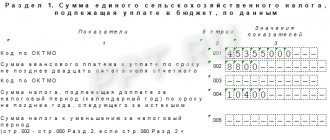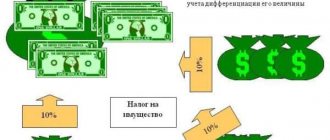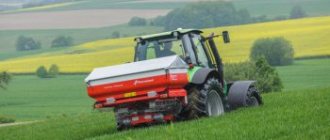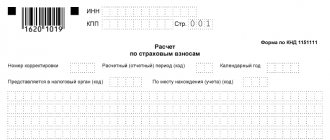What is Unified Agricultural Tax
The Unified Agricultural Tax is a tax regime created specifically for entrepreneurs and organizations engaged in the production of agricultural products.
A feature of the Unified Agricultural Tax, like any other special regime, is the replacement of the main taxes of the general system with one - a single one. The following are not subject to payment on the Unified Agricultural Tax:
- Personal income tax (for individual entrepreneurs).
- Income tax (for organizations).
- VAT (except for export).
- Property tax (except for objects for which the tax base is determined as their cadastral value).
What products are considered agricultural
Agricultural products include products of crop production, agriculture, forestry, and livestock (including those obtained as a result of growing and rearing fish and other aquatic biological resources).
Private Features
The Unified Agricultural Tax payment strategy gives entities the opportunity to replace the list of independent types of money transfers with a single tax. In particular, the payment of agricultural tax eliminates the need for taxes on institutional property, profits, and VAT.
Such a right appears only in cases where special conditions are met, since the Unified Agricultural Tax strategy cannot be applied to every institution working in the field of agriculture. It is important to understand what the Unified Agricultural Tax is in simple words.
According to Article 346 of the Tax Code of the country, the opportunity to make the transition to transferring payments according to the Unified Agricultural Tax appears if the following requirements are correctly met:
- The taxpayer is obliged to carry out the production of agricultural products, for example, crop production, livestock farming, and so on. The legislation allows for the possibility of using such a regime by entities that extract aquatic biological resources.
- The possibility of switching to the Unified Agricultural Tax regime appears only in the case when the share of income from agricultural production is at least seventy percent of the total revenue received by the enterprise.
- The application of the Unified Agricultural Tax scheme does not occur automatically, but after sending a notification to the Federal Tax Service Inspectorate.
It is necessary to focus on the fact that in addition to agricultural producers, the Unified Agricultural Tax scheme can often be used by an institution that provides the necessary services for subjects of the agricultural sector of the economy. But activities for processing agricultural products cannot fall under the preferential structure of the Unified Agricultural Tax.
Upon completion of the transition to this type of taxation, the agricultural producer remains obligated to pay insurance premiums for the company’s hired employees. That's what it is - Unified Agricultural Tax in simple words.
Who has the right to apply the Unified Agricultural Tax in 2020
Individual entrepreneurs and organizations whose income from agricultural activities is more than 70%
from all income.
Fishery organizations and entrepreneurs also have the right to apply the unified agricultural tax, but their income from the sale of fish products must be more than 70%, and the number of employees must not exceed 300 people
.
Note
: from January 1, 2020, LLCs and individual entrepreneurs that provide services to agricultural producers in the field of livestock and crop production can apply the unified agricultural tax (Federal Law of June 23, 2016 No. 216). More details about this here.
Who cannot apply the Unified Agricultural Tax
- Organizations and individual entrepreneurs producing excisable goods (for example, alcohol-containing and alcoholic products, tobacco, etc.).
- Organizations involved in gambling.
- Budgetary and government institutions.
- Individual entrepreneurs and organizations that are not producers of agricultural products, but are only involved in their primary and subsequent processing.
- Individual entrepreneurs and organizations whose income from agricultural activities is less than 70% of their total income.
Restrictions for Unified Agricultural Tax
Additional restrictions for using this mode look like this:
- Manufacturers of excisable goods (alcohol, tobacco, etc.), as well as those involved in the gambling business, cannot work for the Unified Agricultural Tax.
- In order to be able to switch (for already operating business entities) or retain the right to unified agricultural tax, the taxpayer must fulfill the condition that the share of income from the sale of agricultural products or fishing catch is at least 70% of his total income.
- If the average annual number of fishery organizations and individual entrepreneurs using the Unified Agricultural Tax does not exceed 300 people. There is no such requirement for agricultural organizations.
- There are no restrictions on the amount of income received, provided that the requirement for a share of income of at least 70% is met.
Transition to EXSN in 2020
If you are just planning to register an individual entrepreneur or organization, then the notification must be submitted either with the remaining documents for registration, or within 30 calendar days
after registration.
note
, that if you do not meet the specified deadline, you will be automatically transferred to the main taxation regime - the most difficult and unprofitable for small and medium-sized businesses.
You can switch to Unified Agricultural Tax only once
in year. To do this, you must fill out a notification in 2 copies and submit it to the tax authority (individual entrepreneur at your place of residence, organizations at your location).
Existing individual entrepreneurs and organizations can switch to the Unified Agricultural Tax only from January 1 of the next year. To do this, you must submit a notification before December 31
current year.
Transition to Unified Agricultural Tax for individual entrepreneurs and organizations
The transition to the Unified Agricultural Tax (USAT) is voluntary. In order to make the transition to this taxation system, an individual entrepreneur or organization must submit a corresponding application to the territorial body at the place of residence (or at the location of the organization), which can be drawn up in any form or in form No. 26.1-1.
This form of notification of the transition to the unified agricultural tax was approved by Order of the Federal Tax Service of Russia dated January 28, 2013 No. ММВ-7-3/ [email protected]
The application of an individual entrepreneur or organization must indicate such data as the share of income from the sale of agricultural products produced on its own in the total income from all types of activities (for the previous year). Its size must be at least 70%.
Clause 6 of Article 346.2 of the Tax Code of the Russian Federation clarifies who cannot switch to the Unified Agricultural Tax:
The following persons are not entitled to switch to paying the unified agricultural tax:
- Organizations with branches and (or) representative offices;
- Organizations and individual entrepreneurs engaged in the production of excisable goods;
- Organizations and individual entrepreneurs engaged in entrepreneurial activities in the gambling business;
- Budget institutions.
The transition to the unified agricultural tax can be carried out from the beginning of the tax period (from the beginning of the calendar year) or from the date of state registration of the individual entrepreneur (organization).
Calculation of the Unified Agricultural Tax tax
The unified agricultural tax is calculated using the following formula:
EXSN = Tax base x 6%
The tax base
– this is the monetary expression of income reduced by the amount of expenses (expenses for which the tax base can be reduced are listed in clauses 2-4.1, 5 of Article 346.5 of the Tax Code of the Russian Federation).
The tax base can also be reduced by the amount of the loss
(the excess of expenses over income) received in previous years. If losses have been recorded for several years, then they are transferred in the order in which they were received.
Elements of the Unified Agricultural Tax system
The Unified Agricultural Tax can be called a taxation system that is easy to understand. What do you need to know about this system?
- The tax period, that is, the period of time at the end of which the amount of tax payable is calculated, is a calendar year.
- The reporting period based on the results of which the advance tax payment must be calculated and paid is six months. The declaration at the end of the reporting period is not submitted, but by July 25 an advance payment must be made based on the income received in the first half of the year.
- The object of taxation for the Unified Agricultural Tax is income reduced by the amount of expenses, and the tax base is the monetary value of such income. The rules for recognizing income and expenses for calculating agricultural tax are very similar to those that apply when calculating the tax base when calculating the simplified tax system Income minus expenses.
- The tax rate is 6%, and has no regional specifics, and local authorities cannot limit the operation of the Unified Agricultural Tax on their territory.
We draw the attention of all LLCs to the Unified Agricultural Tax - organizations can pay taxes only by non-cash transfer. This is a requirement of Art. 45 of the Tax Code of the Russian Federation, according to which the organization’s obligation to pay tax is considered fulfilled only after presentation of a payment order to the bank. The Ministry of Finance prohibits paying LLC taxes in cash. We recommend that you open a current account on favorable terms.
Tax payment deadlines
Note! The deadlines for paying taxes and filing reports for some individual entrepreneurs and organizations have been postponed due to the coronavirus epidemic. Read the article for details.
The tax period under the Unified Agricultural Tax is a calendar year. Reporting period is half a year.
Organizations and individual entrepreneurs must pay an advance payment during the year based on the results of the reporting period.
The advance payment deadline is no later than 25 days from the end of the reporting period (six months).
In 2020, organizations and individual entrepreneurs must pay an advance payment for six months from July 1-25.
In 2020, it is necessary to calculate and pay tax based on the results of 2018 (minus the previously paid advance).
The deadline for paying tax under the Unified Agricultural Tax for 2020 is until April 1, 2019
.
The deadline for paying tax under the Unified Agricultural Tax for 2020 is until April 1, 2020
.
Example of calculation and payment of Unified Agricultural Tax
Advance payment
IP Petrov I.M. in the first 6 months of 2020, I received an income of 500,000
rubles.
Expenses amounted to 420,000
rubles.
The advance payment will be equal to: 4,800 rubles.
((RUB 500,000 – RUB 420,000) x 6%). It must be paid by July 25, 2020.
Tax at the end of the year
In the next 6 months (from July to December) IP Kotov I.N. received income in the amount of 600 000
rubles, and his expenses amounted to
530,000
rubles.
In this case, the tax at the end of the year will be equal to: 4,200 rubles.
((RUB 1,100,000 – RUB 950,000) x 6% – RUB 4,800). Unified agricultural tax for 2019 will need to be paid no later than April 1, 2020.
How to report
The main reporting document for individual entrepreneurs on the Unified Agricultural Tax is the tax return. Order of the Federal Tax Service of Russia dated 02/01/2016 No. ММВ-7-3/51 “On amendments to the annexes to the order of the Federal Tax Service of Russia dated 07/28/2014 No. ММВ-7-3/384” regulates the latest edition of the form and procedure for filling it out.
The declaration must be submitted no later than March 31 of the year following the reporting year. For entrepreneurs without employees, it is necessary to keep a book of income and expenses (KUDiR). The fact is that the tax period of the Unified Agricultural Tax is a year, and the reporting period is a half-year. Therefore, just like with the simplified tax system, you need to make an advance payment. But unlike the “simplified” payment, the advance must be made once. And you will take the data for calculation in KUDiR.
An entrepreneur with a staff will have to submit more documents.
To the Federal Tax Service (tax office):
- Information on the average number of employees.
- Declarations in form 2-NDFL and 6-NDFL.
In the FSS (Social Insurance Fund) and the Pension Fund (PFR):
- RSV-1 – quarterly.
- ADV-6-5, SZV-6-4, ADV-6-2 (personalized accounting) - quarterly.
- 4-FSS – quarterly.
- At the end of the year, confirm the main type of activity with the Social Insurance Fund - until April 15 of the year following the reporting one.
Tax accounting and reporting
Tax return
At the end of the calendar year, all individual entrepreneurs and organizations using the Unified Agricultural Tax are obliged no later than March 31
fill out and submit a tax return (in case of termination of activity, the declaration is submitted no later than the 25th day of the next month after the month in which the activity was terminated).
Accounting for income and expenses (KUDiR)
In addition to the tax return, individual entrepreneurs must keep a book of income and expenses received (KUDiR).
Accounting and reporting
Individual entrepreneurs using the unified agricultural tax are not required to submit financial statements and keep records.
Organizations on the Unified Agricultural Tax, in addition to the tax return and KUDiR, are required to maintain accounting records and submit financial statements.
Accounting statements for different categories of organizations vary. In general, it consists of the following documents:
- Balance sheet (form 1);
- Statement of financial results (form 2);
- Statement of changes in capital (Form 3);
- Cash flow statement (form 4);
- Report on the intended use of funds (form 6);
- Explanations in tabular and text form.
Read more about financial statements here.
Reporting for employees
They rent only to individual entrepreneurs and organizations that have employees.
Read more about reporting for employees here.
Cash discipline
Organizations and individual entrepreneurs carrying out operations related to the receipt, issuance and storage of cash (cash transactions) are required to comply with the rules of cash discipline.
Read more about cash discipline here.
note
, from 2020, individual entrepreneurs and organizations carrying out settlements using cash and electronic means of payment are required to switch to online cash registers.
Additional reporting
Carrying out certain types of activities, as well as owning certain property, requires paying additional taxes and maintaining records.
Read more about additional taxes for LLCs here.
Read more about additional taxes for individual entrepreneurs here.
Object of taxation and tax base
The object of taxation under the Unified Agricultural Tax is income reduced by expenses. The procedure for determining income and expenses is established by Article 346.5 of the Tax Code of the Russian Federation.
The tax base is the monetary expression of income reduced by the amount of expenses.
The date of receipt of income is the day of receipt of funds into bank accounts and (cash), receipt of other property (work, services), property rights, as well as repayment of debt in another way (cash method).
Expenses are recognized as expenses after they are actually paid.
Income and expenses in foreign currency are converted into rubles at the exchange rate of the Central Bank of the Russian Federation established accordingly on the date of receipt of income (date of expenses). Income received in kind is taken into account based on the contract price, taking into account market prices determined by the rules of Art. 105.3 NK.
The tax base can be reduced for a tax period by the amount of the loss received based on the results of previous tax periods. Taxpayers have the right to carry forward losses to future tax periods within 10 years following the tax period in which the loss was incurred.
Organizations are required to keep records of their performance indicators necessary for calculating the tax base and the amount of unified agricultural tax, based on accounting data.
Individual entrepreneurs may not keep accounting records, but they are required to keep records of income and expenses for the purposes of calculating the tax base for the unified agricultural tax in the book of income and expenses of individual entrepreneurs using the unified agricultural tax. The form and procedure for filling out this book were approved by Order of the Ministry of Finance of Russia dated December 11, 2006 N 169n.
Please note!
From January 1, 2020, taxpayers using the Unified Agricultural Tax can take into account the costs of conducting an independent assessment of the qualifications of employees. The corresponding changes were made by Federal Law dated July 3, 2016 N 251-FZ in paragraphs. 26 clause 2 art. 346.5 Tax Code of the Russian Federation.
Separate accounting
When combining tax regimes, it is necessary to separate
income and expenses for the Unified Agricultural Tax from income and expenses for other types of activities. As a rule, there are no difficulties with the division of income. In turn, with expenses the situation is somewhat more complicated.
There are expenses that cannot be clearly attributed either to the Unified Agricultural Tax or to other activities, for example, the salaries of employees who are engaged in all types of activities at the same time (director, accountant, etc.). In such cases, costs must be divided
into two parts
in proportion
to the income received on an accrual basis from the beginning of the year.
How to calculate tax
Preliminary calculation allows you to determine who benefits from the use of unified agricultural tax. The calculation procedure is described in Articles 346.8–346.9 of the Tax Code of the Russian Federation. Obligations to the budget are calculated from income minus documented and justified costs. In 2018, a rate of 6% is applied in all regions.
Example: A farmer is growing corn. He is assisted by two members of the peasant farm, and no hired employees are involved. By the end of the year, the manufacturer will sell the harvest and primary processed products in the amount of 3,400,000 rubles. The costs will be 2,400,000 rubles. In 2020 it will enjoy VAT exemption.
| Calculation stage | Costing |
| Calculation of insurance premiums | The farmer must pay only fixed fees for himself and the members of the peasant farm. The obligation to calculate contributions on income exceeding 300 thousand is not provided for by law. Payments are made in accordance with paragraph 2 of Article 430 of the Tax Code of the Russian Federation: 29,354+6884 = 36,238 |
| Since, in addition to the head himself, there are two full members in the household, the total amount will be: 36238 × 3 = 108,714 rubles | |
| Determination of the tax base | 3 400 000 – 2 400 000 – 108 714 = 891 286 |
| Tax calculation | 891 286 × 6% = 53 477,16 |
| Total business burden | 53 477,16 +108 714 =162 191,16 |
Payers are required to make advance payments throughout the year. They are calculated based on the ledger of expenses and income. Payments are required to be made at the end of the six months. The law allows 25 days to fulfill the obligation (clauses 2–3 of Article 346.9 of the Tax Code of the Russian Federation). In 2018, the final date for making an advance under the Unified Agricultural Tax was July 25. If the last day falls on a holiday or weekend, the deadline is shifted to the next working day. The final settlement with the budget is made before filing the declaration, that is, until March 31. Advance contributions are reported and deducted from the annual tax amount.
Transition to other taxation systems
Individual entrepreneurs and organizations located on the Unified Agricultural Tax can voluntarily
switch to a different tax regime only from the beginning of the next calendar year. To do this, they need to submit a corresponding notification to the tax authority before January 15 (clause 6 of Article 346.3 of the Tax Code of the Russian Federation).
Mandatory
Unified agricultural tax payers switch to the general taxation system from the beginning of the tax period in which the right to use the unified agricultural tax was lost.
You can switch back to paying the Unified Agricultural Tax no earlier than one year
after losing the right to use it.
Advantages and disadvantages of Unified Agricultural Tax
The use of a single agricultural tax has its advantages :
- legal entities are exempt from paying a number of taxes, incl. VAT, income tax, property tax, etc.;
- individual entrepreneurs on the Unified Agricultural Tax may not pay personal income tax (but only in cases where there is no income eligible for taxation at special rates) and personal property tax on property used for commercial activities;
- the possibility of combining the Unified Agricultural Tax with other tax regimes: UTII (for legal entities) and UTII and PTS (for individual entrepreneurs). When combining tax systems, it is necessary to maintain separate accounting and tax records for them;
- no need to pay the minimum tax in case of losses, as well as the possibility of transferring incurred losses to future tax periods;
- The transition to the Unified Agricultural Tax is of a notification nature.
In addition, the most important positive side of the Unified Agricultural Tax is simple accounting and reporting, as well as two-time payment of tax based on the results of the annual tax period (in the middle and end of the year) and one-time reporting.
At the same time, the agricultural tax also has some disadvantages :
- the share of profitability from activities related to agricultural work must be at least 70% of the total profit;
- a list of expenses that can reduce the tax base less than under the general tax system;
- cash method of income recognition;
- inability to deduct VAT on purchased goods, which, in turn, leads to increased costs.
Calculation of the unified agricultural tax
In order to calculate the amount of tax, it is necessary to use the base in the form of the amount of income received, which is reduced by the amount of expenses incurred in the same period. The exact list of expenses is determined in the Tax Code, and currently includes more than 40 items.
For the Unified Agricultural Tax, the rate is currently set at 6%. In Crimea and Sevastopol, the rate of 4% continues to apply in 2020. Since 2020, municipal authorities can set a differentiated tax rate from 0% to 6%, based on the category of payers.
In order to calculate tax amounts, a business entity must keep accounting records. Moreover, both companies and entrepreneurs should do this.
The value of income and expenses during the year must be recorded on an accrual basis.
Let's look at tax calculation as an example.
Kuritsa LLC uses an agricultural tax system and applies a rate of 6%. In the period from January 2020 to July 2020, it received income in the amount of RUB 10,800,000. At the same time, the company confirmed expenses in the amount of RUB 5,450,000. At the end of six months, the accountant needs to calculate the down payment.
The payment amount is (10,800,000-5,450,000)x6%=321,000 rubles.
This payment must be made by July 25, 2020.
After this, between July and December 2020, Kuritsa LLC received income in the amount of 8,320,000 rubles, and at the same time incurred expenses of 6,890,000 rubles.
Since the calculation must be made on an accrual basis, then:
(10800000+8320000)-(5450000+6890000)x6%=406800 rub.
Since an advance payment was made for the first six months, the following amount must be paid:
406800-321000=85800 rub.
This tax is transferred until March 31 of the year following the year of calculation. The same deadline is set for sending a tax return.
The procedure for transition to a single agricultural tax
There are several ways to start using this system:
- From January 1 of the new year. In this case, the notification must be sent before December 31 of the year preceding the year of intended use of this system;
- By submitting an application to switch to the system when registering a new business entity.
If at the time of registration of the subject the tax system was not selected, then the transition can be made within thirty days from the date of receipt of registration documents. Moreover, the day on which the business entity was registered will be considered the day when the use of the agricultural regime began. It is indicated in the extract from the unified register of the Unified State Register of Legal Entities or the Unified State Register of Legal Entities.
The application for transfer must be submitted for companies - at their location, and for entrepreneurs - at their registration address.
Business entities make the decision to use the Unified Agricultural Tax regime independently. To do this, they need to compare the pros and cons of all other tax systems.
If the Unified Agricultural Tax is applied through a transition from a different tax system, then the application must indicate the share of proceeds from the sale of agricultural products in total revenues. This indicator is determined based on data from the previous year of work.
Attention: before starting to use the unified agricultural tax, a business entity must notify the tax authority about this. If this is not done, then the right to use this system will not be established, and the tax authority will consider that the company or individual entrepreneur is on the previous system.
When switching to the Unified Agricultural Tax, it must be applied before the end of the current year. It is prohibited to refuse to apply it if all criteria meet those established by law.
